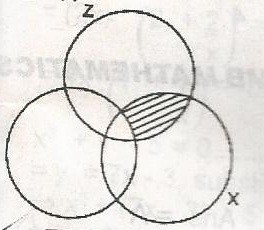1993 - JAMB Mathematics Past Questions and Answers - page 4
31
If two angles of a triangle are 30o each and the longest side is 10cm. Calculate the length of each of the other sides
A
5cm
B
4cm
C
3√3 cm
D
10\(\frac{3}{3}\)cm
Ask EduPadi AI for a detailed answer
Share this question
32
Quantities in the proportions 1, 4, 6, 7 are to be represented in a pie chart. Calculate the angle of the sector with proportion 7
A
20o
B
80o
C
120o
D
140o
Ask EduPadi AI for a detailed answer
Share this question
33
The following marks were obtained by twenty students in an examination: 53, 30, 70, 84, 59, 43, 90, 20, 78, 48, 44, 60, 81, 73, 50, 37, 67, 68, 64, 52. Find the numbers of students who scored at least 50 marks
A
6
B
10
C
13
D
14
Ask EduPadi AI for a detailed answer
Share this question
34
\(\begin{array}{c|c} Weight(s) & 0 -10 & 10 - 20 & 20 - 30 & 40 - 50\ \hline \text{Number of coconuts} & 10 & 27 & 19 & 6 & 2\end{array}\)
Estimate the mode of the frequency distribution above
Estimate the mode of the frequency distribution above
A
13.2g
B
15.0g
C
16.8g
D
17.5g
Ask EduPadi AI for a detailed answer
Share this question
35
The mean of the ages of ten secondary school pupils is 16 but when the age of their teacher is added to it the men becomes 19. Find the age of the teacher
A
27
B
35
C
38
D
49
Ask EduPadi AI for a detailed answer
Share this question
36
\(\begin{array}{c|c} Class & Frequency\ \hline 1 - 5 & 2\6 - 10 & 4\11 - 15 & 5\16 - 20 & 2 \ 21 - 25 & 3\26 - 30 & 2\31 - 35 & 1\36 - 40 & 1 \end{array}\)
Find the median of the observation in the table given
Find the median of the observation in the table given
A
11.5
B
12.5
C
14.0
D
14.5
Ask EduPadi AI for a detailed answer
Share this question
37
A number is selected at random between 20 and 30, both numbers inclusive. Find the probability that the number is a prime
A
\(\frac{2}{11}\)
B
\(\frac{5}{11}\)
C
\(\frac{6}{11}\)
D
\(\frac{8}{11}\)
Ask EduPadi AI for a detailed answer
Share this question
38
Calculate the standard deviation of the following data: 7, 8, 9, 10, 11, 12, 13.
A
2
B
4
C
10
D
11
Ask EduPadi AI for a detailed answer
Share this question
39
The chances of three independent events X, Y, Z occurring are \(\frac{1}{2}\), \(\frac{2}{3}\), \(\frac{1}{4}\) respectively. What are the chances of Y and Z only occurring?
A
\(\frac{1}{8}\)
B
\(\frac{1}{24}\)
C
\(\frac{1}{12}\)
D
\(\frac{1}{4}\)
Ask EduPadi AI for a detailed answer
Share this question
40

A
x \(\cap\) z
B
xo \(\cap\) y \(\cap\) z
C
x \(\cap\) yo \(\cap\) z
D
x \(\cap\) y \(\cap\) zo
Ask EduPadi AI for a detailed answer
Share this question